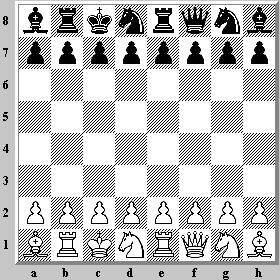
SP835: BRKNRQNB
Once again, the four weak Pawns aren't particularly vulnerable to any immediate attack. Of the 52 games in the CCRL collection, the following first moves were played by White...
21 1.b4
11 1.b3
7 1.Nf3
7 1.e4
3 1.g3
3 1.Nc3
...In this position the players don't have the option of castling on the first move, but the other moves are mainly mirrors of the most popular moves for SP115, for the same reasons. I can't explain the overwhelming preference for a push of the b-Pawn, especially 1.b4, where the equivalent SP115 move (1.g4) was one of three equally popular openings. Perhaps it's just a statistical quirk of the small CCRL samples. After 1.b4, the most popular responses for Black were...
8 1...b5, and
6 1...e5
...All six games that started 1.b4 e5 ended in victory for White. Is this another statistical quirk or is there a structural problem with Black's position that needs special attention?
My favorite method to start evaluating a new chess960 start position is to first look at the castling options. In SP835, both players can castle O-O-O by simply moving the d-Knight out of the way. Castling O-O requires more preparation. Both Knights have to move off their start squares and the Queen has to move somewhere. The best square for the Queen is far from obvious and will likely depend on the opponent's scheme of initial development.
My first candidate move here mirrors my choice for SP115: 1.e4. It again stakes a claim in the center, opens a diagonal for the Queen, creates a strong point for the Knight on e3, and is protected by the Rook. That's a lot for a single move to accomplish.

No comments:
Post a Comment